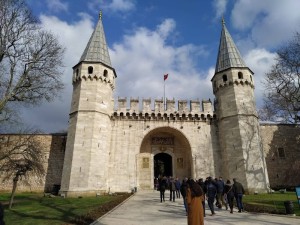ISTANBUL TOPKAPI PALACE 2023
ISTANBUL TOPKAPI PALACE
Topkapı Palace was built by Mehmed the Conqueror between 1460 and 1478 after the conquest of Istanbul and took its present form with the additional structures built by the sultans who followed it. The construction, which started with landscaping and mansions in Sarayburnu, which is called the olive grove, continued with the walls called Sûr-ı Sultânî (Kal'a-i Sultânî). The palace was called Saray-ı Cedid-i Âmire for many years because of the old palace in Beyazıt, and then the name Top Gate Palace was started to be used because of the name of the pavilion called the Collective Gate. The palace, where additions were made over time, continued to be the center of life and administration until the middle of the 19th century. By the 1840s, Dolmabahçe Palace was built between 1843 and 1856 as the existing palace was insufficient to meet the requirements of the 19th century state protocol, and after a while, the living and administrative center for the dynasty was completely moved to Dolmabahçe Palace.
Topkapi Palace is located in one of the oldest historical districts of Istanbul. Located on the historical Istanbul Peninsula between the Sea of Marmara, the Bosphorus and the Golden Horn, the palace is one of the iconic structures of Istanbul. Topkapi Palace, which was built on an area of 700,000 square meters on the East Roman acropolis in Sarayburnu, was the administrative, educational and artistic center of the empire for about four hundred years until the 31st Ottoman Sultan Sultan Abdulmecid; It was also the residence of the sultans. Topkapı Palace, which was abandoned after the dynasty moved to Dolmabahçe Palace from the middle of the 19th century, has preserved its historical importance and value.
Topkapı Palace, which was turned into a museum on April 3, 1924, after the foundation of the Republic of Turkey, has the distinction of being the first museum of the Republic. Topkapi Palace, which covers an area of approximately 350,000 square meters today, excluding Gulhane Park; It is one of the largest museum-palaces in the world with its structures, architecture, collections and approximately 300,000 archive documents.
The second courtyard of the palace is the Divan Square, also known as the Justice Square, where the state administration takes place. In this courtyard, which has been the scene of many ceremonies throughout history, there is the Divan-ı Hümâyûn (Kubbealtı) where the council meetings were held and the Divan-ı Hümâyûn Treasury next to it. In this courtyard, there is also the Tower of Justice behind the Divan structure, the entrance to the Harem Chamber next to Kubbealtı, the Zülüflü Baltacılar Ward and the Has Stables.
The third courtyard of the palace is also called the Enderûn Courtyard. In this section, there are large and small rooms, the Sultan's Supply Room, Doğancılar Ward (Şahinciler), Seferliler Ocağı, Kilerli Ward, Enderun Treasury and Has Room (Holy Relics Office), as well as structures belonging to the Palace School. In Enderun, which is located in the third courtyard, when you enter Bâbüssaâde, there were the dormitories on the right and left, and when you continue from the right, there was the treasure section known as the Fatih Mansion on the upper right. The four-domed stone structure leaning against the Harem section in the upper left corner was the Has Room. This place was mostly called Hırka-i Saadet Department after the relics were brought during the reign of Yavuz Sultan Selim.
In the fourth courtyard, which is the last courtyard, there are the sultan's pavilions and hanging gardens. In this section, there are the Baghdad and Revan Kiosks, which are the most distinguished examples of Ottoman classical pavilion architecture, and the Iftariye Gazebo. XVIII. The Sofa Mansion, which is thought to have been built in the 16th century, is a structure based on the Tulip Garden wall and is also known as the Kara Mustafa Pasha Mansion. The couplets of the famous Ottoman poet Hâkanî Mehmed Bey are written inside this wooden mansion and on the upper part of its walls.

